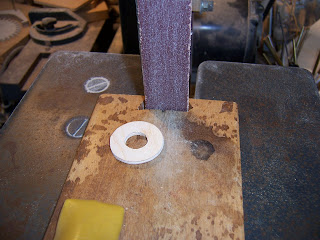Bird Of Paradise by Derek Hugger
Derek writes: "Hi Clayton,
I'm finished with my first woodworking project ever. Not bad if I do
say so myself ;). I'm having a little trouble keeping it running;
sometimes it goes for several hours (went for close to 12 once), and
sometimes it only runs for 5 minutes. I'm thinking it's just some
friction somewhere. Anyway, thank you again for designing these
beautiful pieces of art. Nautilus is next for me! Until then, here are
some images of the Bird of Paradise. Throw on some 3D glasses and have
a look!
Best,
Derek"
say so myself ;). I'm having a little trouble keeping it running;
sometimes it goes for several hours (went for close to 12 once), and
sometimes it only runs for 5 minutes. I'm thinking it's just some
friction somewhere. Anyway, thank you again for designing these
beautiful pieces of art. Nautilus is next for me! Until then, here are
some images of the Bird of Paradise. Throw on some 3D glasses and have
a look!
Best,
Derek"
Yes, Derek, your first attempt at a woodworking project really did turn out nicely. It turned out fantastic!
It is nice to see that you did your frame in a darker wood. I don't think I'll show your pictures to my Bird Of Paradise. She'll just get jealous.
These are the first pix I've ever gotten back that were taken in 3D! I don't have 3D glasses, but I'll be on the hunt for them now, just to be able to see these unique pix you've sent.
If your clock is running sometimes for 12 hours and sometimes for 5 minutes, it could be an internal friction problem, and you might think about liberally spraying everything with silicone spray. (Do not do this, however, if you used a finish on your clock that will be ruined by the silicone's propellant.)
Spray the tooth surfaces of the wheels and pinions, and where the arbors meet the frame, and if that takes care of it, yes, there is a tiny bit of internal friction somewhere. However, more commonly, it sounds like something may be coming out of adjustment, and the most common place for that to happen on the Bird Of Paradise, and on Swoopy is where the Verge screws to the Pallet Arbor.
The Verge is that No-Named thing in the plans that has the red vertical line and the Pallets and Resters attach to.
Thanks for bringing that omission of nomenclature to my attention. I have now properly named the Verge in the BOP plans. Anyway, back to your problem...
Sometimes another Allen Screw up from the bottom of that same hole helps hold the Verge more securly to the arbor.
If these don't fix the problem, read over my FAQ's on depthing, and "Why Doesn't My Clock Run," and tweaking, because I'm sure that a clock that runs sometimes for 12 hours is soon to be a very fine runner for 24.
Aloha, Clayton















































